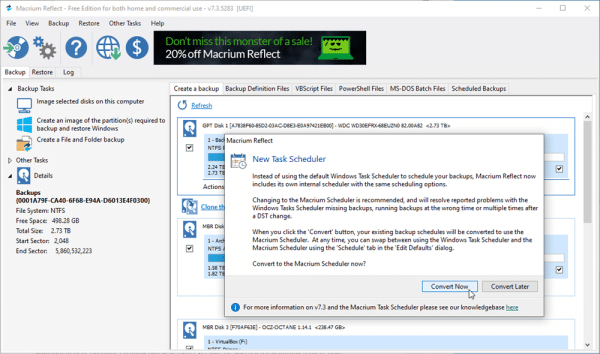

- #MACRIUM REFLECT TRIAL NOTICE DRIVER#
- #MACRIUM REFLECT TRIAL NOTICE UPGRADE#
- #MACRIUM REFLECT TRIAL NOTICE FULL#
- #MACRIUM REFLECT TRIAL NOTICE FREE#
It's a good theory re: SSD temperatures, and I will try to monitor them, but I don't think this is what the issue was. I'm wondering if this feature was enabled in your tests. I know that it is possible to enable a feature in Reflect called Rapid Delta Restore which significantly speeds up restore speed. However, I do not recall seeing any comparisons of restore times.
#MACRIUM REFLECT TRIAL NOTICE FREE#
I have also read posts in the ATI forum indicating that the paid version of Macrium Reflect is even faster than the free version. Don't know if this explains the differences you observed, though.įor what it's worth, the conventional wisdom (from users who have posted elsewhere in this thread, as well as former ATI users who have posted on the Macrium forum), which is based on experience and occasional benchmark tests, is that Macrium Reflect is 3-5 times faster than ATI when backing up images. I just haven't tried it yet as it takes much more time than doing a local backup of the 1TB NVMe drive to the local I asked about the drive temperatures due to the well-known throttling of SSD transfer rates at elevated temperatures. Macrium might not be the bottleneck for that use case. Those are much slower, about 5TB of data that normally takes 3.5 hours or so, around 4 Gbps effective over 10 GBASE-T, to a ZFS array.
#MACRIUM REFLECT TRIAL NOTICE FULL#
I haven't compared full backup to NAS yet. TIH 2021 has also slowed down massively vs 2019. I may resell it unused due to the performance issue. I got my TIH 2021 5-license box in the mail just now from Newegg. So, really, I'm not doing this because of high performance needs, but I do notice that it slowed down considerably.
#MACRIUM REFLECT TRIAL NOTICE DRIVER#
But if it doesn't, ATI boot media will normally work, with only the mouse being required, and no need for the NIC driver or proper keyboard layout. Restoring the OS from a local TIB file on the SSD array usually works from GUI. I have been able to add the NIC driver to it, but not to set the correct keyboard layout to be able to login and access the NAS. So, I'm forced to use the USB WinPE media to restore the OS. If I do it from the GUI under Windows, when it restarts, it always fails, because it's missing the Aquantia NIC driver.

The reason I use a local drive as destination to backup my OS is that restoring the OS from NAS is too much of a PITA. The more conventional tests I've done between SSD to HDD have given very similar results for both ATI and MR using partition image and file/folder backups when both are on max compression. However, if there is a performance difference it should be reported and investigated. Usually backup destination drives are much slower than that for home and workstation users which this is aimed at. "when doing a local backup from an NVMe SSD to a SATA SSD array"Ī very unique backup scenario to SSD arrays. Will check if I can open a ticket with Macrium. I wasn't able to register for the Macrium forum due to not having a license. I only measured backup times, not restore times. But it was random incompressible data in all cases. When I filled the source drive with h2testw, the data was not identical, as I created, deleted, and recreated it.
#MACRIUM REFLECT TRIAL NOTICE UPGRADE#
For TI2019 and the upgrade to TI2021, no reboot. For Macrium, I did reboot, as the installer required it. If you are interested in Macrium Reflect as a an alternative to ACPHO but are experiencing issues related to unsatisfactory performance or anything else, you can turn to the excellent user forum for assistance with trouble-shooting, or open a support ticket with Macrium. Was the state of the system comparable for each of your tests? (e.g., same drive capacity, drive temperatures cool, same cables, system freshly rebooted, etc.) Does the measured restore time include time for validating the checksums in the image file, or only the restore process?


 0 kommentar(er)
0 kommentar(er)
